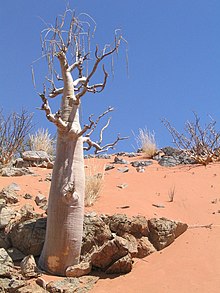Moringa (genus)
| Moringa | |
|---|---|

| |
| Moringa ovalifolia | |
| Scientific classification | |
| Kingdom: | |
| (unranked): | |
| (unranked): | |
| (unranked): | |
| Order: | |
| Family: | Moringaceae
|
| Genus: | Moringa |
| Type species | |
| Moringa oleifera | |
| Species | |
|
See text | |
| Synonyms | |
|
Donaldsonia Baker f. | |
Moringa, native to parts of Africa and Asia, is the sole genus in the flowering plant family Moringaceae. The name is derived from the Malayalam word Muringa (മുരിങ്ങ) which refer to M. oleifera.[3] It contains 13 species from tropical and subtropical climates that range in size from tiny herbs to massive trees.
The most widely cultivated species is Moringa oleifera, a multipurpose tree native to the foothills of the Himalayas in northwestern India and cultivated throughout the tropics.[4] M. stenopetala, an African species, is also widely grown, but to a much lesser extent than M. oleifera.
Moringa grows quickly in many types of environments.
Nutritional content
Much of the plant is edible by humans or by farm animals. The leaves are rich in protein, vitamin A, vitamin B, vitamin C and minerals.[4] 100g of fresh Moringa leaves have 8.3 g protein, 434 mg calcium, 404 mg potassium, 738 μg vitamin A, and 164 mg vitamin C[5]
Feeding the high protein leaves to cattle has been shown to increase weight gain by up to 32% and milk production by 43 to 65%.[6] The seeds contain 30 to 40% oil that is high in oleic acid, while degreased meal is 61% protein.[7] The defatted meal is a flocculant and can be used in water purification to settle out sediments and undesirable organisms.[8]
Farming worldwide
Moringa cultivation is on the rise in Honduras. There are claims that it is a profitable means of combating deforestation, but Moringa is not native to the forests of the New World. As of 2012 support for Moringa farmers is being offered by the Honduran federal government through the Secretary of Agriculture and by private foreign investment firms. The plant's market potential is widespread given its easy growth and high nutrient content. As described below, the plant is valued for its leaves and high-protein seeds. It can also be made into defatted meal. Moringa oleifera silviculture is being promoted as a means to combat poverty and malnutrition.[6]
More recently, the Moringa oleifera is being cultivated in poverty-stricken nations, such as Niger, as a primary source of food and nutrients.[9][10]
In Mexico, Reserva Las Estacas, state of Morelos, includes the cultivation of Moringa.[11][12]
In Ecuador, Moringa Source LLC http://www.moringasource.com has now begun an extensive plantation for leaf production and oil production in the area of Limoncito, Santa Elena province.
List of species
- Moringa arborea Verdc. (Kenya)
- Moringa borziana Mattei
- Moringa concanensis Nimmo
- Moringa drouhardii Jum. – Bottle Tree (southwestern Madagascar)
- Moringa hildebrandtii Engl. – Hildebrandt's Moringa (southwestern Madagascar)
- Moringa longituba Engl.
- Moringa oleifera Lam. (syn. M. pterygosperma) – Horseradish Tree (northwestern India)
- Moringa ovalifolia Dinter & Berger
- Moringa peregrina (Forssk.) Fiori
- Moringa pygmaea Verdc.
- Moringa rivae Chiov.
- Moringa ruspoliana Engl.
- Moringa stenopetala (Baker f.) Cufod.[13]
References
- ^ a b "Genus: Moringa Adans". Germplasm Resources Information Network. United States Department of Agriculture. 1996-09-17. Retrieved 2011-09-26.
- ^ "Moringa Adans". TROPICOS. Missouri Botanical Garden. Retrieved 2009-12-30.
- ^ Quattrocchi, Umberto (2000). CRC World Dictionary of Plant Names: Common Names, Scientific Names, Eponyms, Synonyms, and Etymology. Vol. Volume 3: M-Q. CRC Press. p. 1731. ISBN 978-0-8493-2677-6.
{{cite book}}:|volume=has extra text (help) - ^ a b Janick, Jules (2008). The Encyclopedia of Fruit & Nuts. CABI. pp. 509–510. ISBN 978-0-85199-638-7.
{{cite book}}: Unknown parameter|coauthor=ignored (|author=suggested) (help) - ^ "West African Food Composition Table" (PDF). Retrieved 2012-11-01.
- ^ a b "The Moringa Tree Moringa oleifera" (PDF). Trees for Life International. Retrieved 2009-12-29.
- ^ Schill, Susanne Retka (2008-05-14). "Multidimensional Moringa". Biodiesel Magazine. Retrieved 2011-09-26.
- ^ Schwarz, Dishna (2000). "Water Clarification using Moringa oleifera" (PDF). Technical Information W1e. Gate Information Service. Retrieved 2011-09-26.
{{cite journal}}: Unknown parameter|month=ignored (help) - ^ Miracle Tree helps in Niger's food crisis
- ^ Moringa: The Tree of Life
- ^ Reserva Las Estacas, Morelos, Mexico (in Spanish)
- ^ Agrin, A.C., a civil association related to Reserva Las Estacas
- ^ "Subordinate Taxa of Moringa Adans". TROPICOS. Missouri Botanical Garden. Retrieved 2009-12-30.
